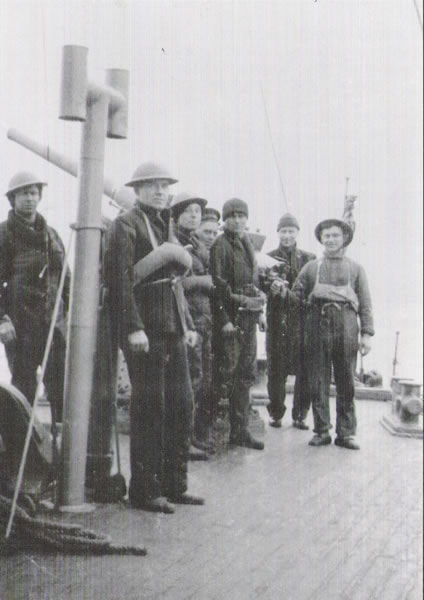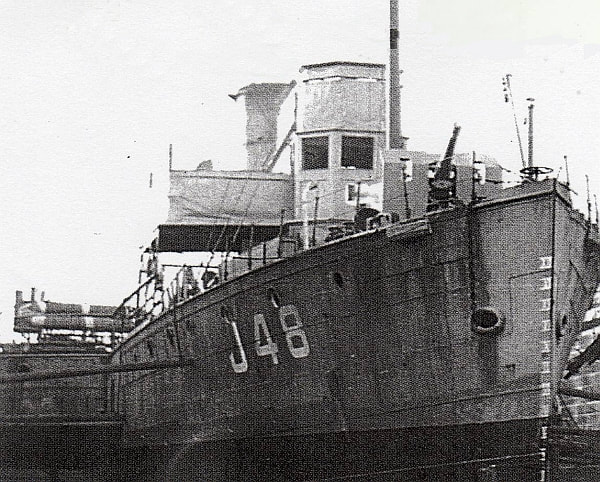The War Years
Medway Queen was requisitioned for war service on 9th September 1939 and taken to the shipyard of the General Steam Navigation Company in Deptford Creek where she was transformed from her black, white and cream peacetime livery to battleship grey. The refit included considerable modification to her aft end where part of the saloon was cut away to accommodate the mine-sweeping gear. Additional items were fitted such as a 12pdr gun and anti-aircraft machine guns. The bridge was extended and enclosed. She went into the yard as a pleasure steamer but came out as HMS Medway Queen with her pennant number N48 which later became J48. The commissioning ceremony took place in November and sea trials commenced.
Her first wartime captain was Sub-Lieutenant R.D.C.Cooke, RNVR. He was a veteran of the first world war. The other officers included Sub-Lieutenant J.D. Graves RNR and Lieutenant Jolly RN. who was a peacetime yachtsman. The navigator of HMS Medway Queen was Lieutenant Keilly who, despite being of pensionable age, managed to persuade the Captain to take him on as a Junior Officer because of his long deep sea experience. Other crew members included Petty Officer Crossley who was to become the Coxswain and also Petty Officer McAllister who became the designated Bo'sun of the upper deck.
After gun trials at Sheerness adjustments were made in Chatham Dockyard. HMS Medway Queen was then posted to Harwich in January 1939, initially as an independent ship and later as part of the 9th Minesweeping Flotilla. During the winter of 1939 parts of the Medway and Thames estuaries were frozen over but the Flotilla continued their daily sweeps for mines with the assistance of a tug to break any patches of ice that lay ahead of them. The harshness of the cold winters took their toll on the Medway Queen with faults appearing in the ship's structure. This lead to her being ordered into Chatham dockyard in February 1940 for repairs and installation of de-gaussing equipment as protection against magnetic mines.
In March 1940 HMS Medway Queen joined the 10th Paddle Mine-sweeping Flotilla in Dover The flotilla was commanded by Commander Greig RN. of HMS Sandown (another paddle steamer, originally from the Isle of Wight). At about this time the Commanding Officer changed to Lt. A. T. Cook RNR. when his predecessor retired through ill health. Lt. A. T. Cook commanded Medway Queen throughout the Dunkirk Evacuation and for some time afterwards. HMS Medway Queen patrolled the Straits of Dover acting as sub-divisional leader. Often the paddle steamer would anchor in pre-arranged locations in order to act as lookout. It was when the Medway Queen was fulfilling this duty on 27th May 1940 that she received orders to head to the beaches of Dunkirk to embark some troops that would be waiting there. Even then the crew of HMS Medway Queen had no idea of the enormous operation known as "Operation Dynamo".
Her first wartime captain was Sub-Lieutenant R.D.C.Cooke, RNVR. He was a veteran of the first world war. The other officers included Sub-Lieutenant J.D. Graves RNR and Lieutenant Jolly RN. who was a peacetime yachtsman. The navigator of HMS Medway Queen was Lieutenant Keilly who, despite being of pensionable age, managed to persuade the Captain to take him on as a Junior Officer because of his long deep sea experience. Other crew members included Petty Officer Crossley who was to become the Coxswain and also Petty Officer McAllister who became the designated Bo'sun of the upper deck.
After gun trials at Sheerness adjustments were made in Chatham Dockyard. HMS Medway Queen was then posted to Harwich in January 1939, initially as an independent ship and later as part of the 9th Minesweeping Flotilla. During the winter of 1939 parts of the Medway and Thames estuaries were frozen over but the Flotilla continued their daily sweeps for mines with the assistance of a tug to break any patches of ice that lay ahead of them. The harshness of the cold winters took their toll on the Medway Queen with faults appearing in the ship's structure. This lead to her being ordered into Chatham dockyard in February 1940 for repairs and installation of de-gaussing equipment as protection against magnetic mines.
In March 1940 HMS Medway Queen joined the 10th Paddle Mine-sweeping Flotilla in Dover The flotilla was commanded by Commander Greig RN. of HMS Sandown (another paddle steamer, originally from the Isle of Wight). At about this time the Commanding Officer changed to Lt. A. T. Cook RNR. when his predecessor retired through ill health. Lt. A. T. Cook commanded Medway Queen throughout the Dunkirk Evacuation and for some time afterwards. HMS Medway Queen patrolled the Straits of Dover acting as sub-divisional leader. Often the paddle steamer would anchor in pre-arranged locations in order to act as lookout. It was when the Medway Queen was fulfilling this duty on 27th May 1940 that she received orders to head to the beaches of Dunkirk to embark some troops that would be waiting there. Even then the crew of HMS Medway Queen had no idea of the enormous operation known as "Operation Dynamo".
After Dunkirk, following repairs in Portsmouth Dockyard, HMS Medway Queen returned to mine-sweeping duties. In July the 10th MSF moved to Harwich and in August Medway Queen joined the 8th MSF based on the river Tyne. Lt. Jack Horrex took command from March 1942 until October 1943 when the ship briefly became an accommodation vessel. It had not been an easy posting and two other members of the flotilla (HMS Southsea and HMS Snaefell) were sunk during 1941.
She was recommissioned in April 1944 with Ty Lt. Robert Pakenham RNR in command. Ty Lt Colin T Wilson RNVR took over in September and Charles McAra in June 1945. Medway Queen was engaged in minesweeper training duties based at Granton in Edinburgh. Mine-sweeping (and training) continued for some time after the end of the war and we think it was not until 1946 that the ship was released from the Royal Navy and returned to civilian use.
She was recommissioned in April 1944 with Ty Lt. Robert Pakenham RNR in command. Ty Lt Colin T Wilson RNVR took over in September and Charles McAra in June 1945. Medway Queen was engaged in minesweeper training duties based at Granton in Edinburgh. Mine-sweeping (and training) continued for some time after the end of the war and we think it was not until 1946 that the ship was released from the Royal Navy and returned to civilian use.








